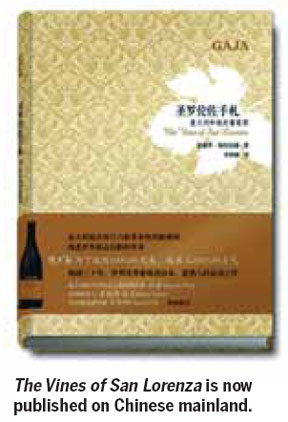
 'Taken 2' grabs movie box office crown
'Taken 2' grabs movie box office crown
 Rihanna's 'Diamonds' tops UK pop chart
Rihanna's 'Diamonds' tops UK pop chart
 Fans get look at vintage Rolling Stones
Fans get look at vintage Rolling Stones
 Celebrities attend Power of Women event
Celebrities attend Power of Women event
 Ang Lee breaks 'every rule' to make unlikely new Life of Pi film
Ang Lee breaks 'every rule' to make unlikely new Life of Pi film
 Rihanna almost thrown out of nightclub
Rihanna almost thrown out of nightclub
 'Dark Knight' wins weekend box office
'Dark Knight' wins weekend box office
 'Total Recall' stars gather in Beverly Hills
'Total Recall' stars gather in Beverly Hills
The Italian connection
Updated: 2012-06-11 10:38
By Ye Jun (China Daily)
|
||||||||
Gaia Gaja thinks Italian wines are perfect for the Chinese palate.
"People today mostly pay attention to loud voices and high tones, not to whispers," says Gaja, a fifth-generation winemaker from the Gaja winery in Italy's Piedmont region.
"Nebbiolo, Italy's local grape varietal, is low-note, and will take some effort to be made beautiful." By high note wines, Gaja refers to wines with a lot of perfume, and powerful alcohol.
"It has very light perfume at first, and smells like water," she says. "Aroma comes out after 10 minutes. It is a wine to pay attention to and engage yourself with."
Gaja was at a Beijing event, organized by ASC Fine Wines, to promote her family wines. Earlier on at the Italian Embassy's culture office, she had presented the Chinese edition of The Vines of San Lorenza in its debut in Chinese mainland.
Written by American writer Edward Steinberg, the book was published in the United States in 1993, where 80,000 copies were sold. It has since been translated into more than 10 languages.
Steinberg had stayed at Gaja for a year, and wrote the book based on his diary.

The Vines of San Lorenza had been translated into traditional Chinese and published in Taiwan, but it is the first time it has been translated into simplified script and published in the Chinese mainland.
"Translating the book took me inside the wine brewers' world," says translator Chantal Chi, a wine writer based in Shanghai. "The book shows all dreams can come true, and success depends on details and persistence."
The Vines of San Lorenza describes how Angelo Gaja, Gaia's father, made Gaja wines in 1989, and how he made Barbaresco an internationally famous vintage.
Angelo made great wines not just with local grape varietals, but introduced French varietals, such as Cabernet Sauvignon, Chardonnay and Sauvignon Blanc. He also modernized the process by introducing barriques in wine making.
Gaia Gaja says just like the tomato and peaches introduced into Italy, French grape varietals are adapting well and producing quality wines in Italy.
"They reflect the characters of the soil, which grow more and more distinct with time," she says.
Gaja winery has a 20-year advantage over other local wineries in term of technology. They have 80-year-old Nebbiolo vines that cannot be replaced.
The winery, founded in 1859, has insisted on producing only top quality wines, to the extent that they skipped bottling wines under their own label in certain years if they felt the vintage would not be good - like in 1946, 1972, 1980, 1984, 1992, and 2002.
Gaia Gaja calls her home winery the "Ferrari of wines".
"Gaja is a wine that reflects the culture of its origin, and all the work people have done to produce it," she says.
The fact that Chinese culture is all about balance of yin and yang makes Gaja believe the Chinese will appreciate a delicate wine like Nebbiolo.
She does not believe the Chinese only like Bordeaux wines. It is just what they know at present, and if they don't drink Italian wines, "they are missing a world".
That may change in the next three years, as Gaja pays more attention to the Chinese market and aims for a more "balanced world distribution".
yejun@chinadaily.com.cn
Most Viewed
Editor's Picks

|

|

|

|

|

|
Today's Top News
Health new priority for quake zone
Xi meets US top military officer
Japan's boats driven out of Diaoyu
China mulls online shopping legislation
Bird flu death toll rises to 22
Putin appoints new ambassador to China
Japanese ships blocked from Diaoyu Islands
Inspired by Guan, more Chinese pick up golf
US Weekly

|

|






